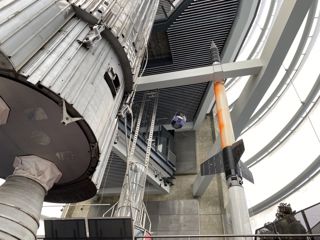
UK in Space: Prospero
- 26th Oct 2021
- Author: Josh Barker
We are such stuff as dreams are made on
This October we will celebrate the 50th anniversary of the launch of Prospero.
This small 66kg satellite represented a landmark achievement as its launch cemented Britain’s place in the spaceflight landscape. The successful flight of Prospero on the Black Arrow rocket made the United Kingdom the sixth of only ten nations to successfully conduct an orbital launch where all components, rocket and payload, were developed by that nation. While a huge technical achievement for the country, the mission was to be bittersweet as the Black Arrow rocket programme had been cancelled on economic grounds before Prospero’s flight; the little satellite only being okayed for flight as it had already been dispatched to the Australian launch site.
Whilst the UK would not continue rocket development, thankfully the success of the Prospero mission helped to launch the UK on a journey to become a world-leading satellite constructor. This industry has grown to become a key part of the UK’s economy, employing over 45,000 people and supporting over £360 billion of economic activity.
As the UK prepares to re-enter the world of satellite launches from UK based spaceports it seems only right to reflect on where it all started.
What's past is prologue
Prospero began life as ‘Puck’, an experimental mission conceived in Farnborough by the Royal Aircraft Establishment.
This military research institution has long been a centre for aviation innovation here in the UK. Continuing in this tradition, Prospero was designed to lay the groundwork for future communication satellites. It featured a host of new features from alternate solar panel designs to space dust detectors.
Alongside this, even the components of Prospero pushed for innovation. The data handling system was overhauled to create something more modular to make for easier repair or greater customisation in future missions. A novel method for tracking the spin and orientation of the spacecraft was developed. Even the conventional power supply was redesigned to allow higher redundancy and the ability to individually control the loads on the system, allowing for fault-finding, even during orbital operation.
These designs and improvements would go to form large parts of the Ariel satellite programme despite initial concerns that they may not be functional enough to support future missions.
Into thin air
Once completed, the satellite was shipped from the UK to Australia. Its destination was the Woomera Range Complex. It was during this trip that the satellite was renamed. Initially designated Puck, following the announcement of Black Arrow’s cancellation, the designers renamed the satellite to Prospero. A tongue in cheek reference to a Shakespearean character set to sea on a ‘rotten carcass’ of a boat. The character of Prospero is also thought to have delivered Shakespeare’s retirement speech in one of his soliloquies, a humorous jab by the engineering team, despite the less-than-ideal situation.
At 04:09 GMT on 28 October 1971 the Gamma 8 engine of Black Arrow’s first stage roared into life and begun this historic mission. It was the fourth and final launch of this British-made rocket. The flight could be called textbook for the most part. However, upon separation of the Prospero satellite once orbit had been achieved, a small collision occurred. Ironically, due to overperformance, the third stage Waxwing engine continued to thrust after separation causing it to collide with the satellite. This collision caused one of the spacecraft’s antennae to be detached. Ultimately this didn’t impact Prospero’s performance and the mission was able to be completed. Just 12 minutes after lift-off, Prospero was in orbit. Averaging 1,000 km above the Earth, Prospero circled the globe every 104 minutes, transmitting data home via a research station based in the Falkland Islands.
O brave new world
Prospero officially operated, gathering data and transmitting it home, until 1973 when its tape recorders stopped working. From that point it was unable to record data, however, it could still operate the radio transmitters and could be heard in orbit for decades after. Officially decommissioned in 1996, an attempt was made to reconnect with the satellite in 2011. A project by the Mullard Space Science Laboratory wanted to communicate with the satellite as part of its 40th anniversary celebrations. Unfortunately, the project turned out trickier than previously anticipated and the team behind it did not have the resources to get it fully operational.
There is still hope though, Prospero’s orbit is not set to decay until 2070, nearly 100 years after launch. It stands as an orbital monument to the UK’s space legacy. It is still spottable with a good set of binoculars and the right timing (Track the satellite here). As we move into the next era of space exploration, it is often good to reflect on the steps that got us to where we are.
The UK stands on the precipice of launching UK built rockets into space, carrying UK built spacecraft, as part of the new UK Space Agency spaceports programme. Here at the National Space Centre we will certainly be tipping our hats to celebrate the 50th anniversary of Prospero.
About the author: Josh Barker is the Planetarium Coordinator and Education presenter at the National Space Centre.






